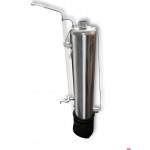
Why Jars Pop Off in an Autoclave
A home autoclave greatly simplifies the canning process and saves time. Cooking occurs under pressure exceeding atmospheric pressure and temperatures above 100°C. This is necessary for sterilizing cans from pathogenic microorganisms, ensuring the safety of the products and extending their shelf life.
In the autoclave, high pressure is created during sterilization, and since the unit is tightly sealed, neither liquid nor air can escape.
To eliminate all harmful bacteria, the product must be boiled at a temperature of at least 100°C for at least 20 minutes. Some pathogenic organisms, including botulinum toxin, can survive under these conditions. An autoclave allows for the use of higher temperatures at which any bacteria are killed.
The drawback of this method is that cans can burn in the autoclave if overcooked. Always follow the recipe and adhere to the temperature and pressure that will kill bacteria but keep the product in a normal and edible condition. The pressure at which to cook in an autoclave depends on the type of product and the required temperature. For example, vegetables should not be cooked at temperatures above 100°C, while meat should not be processed below 110°C. The temperature norms for cooking different products can be found in the cookbook that comes with the autoclave.
Increasing the temperature in the autoclave will also increase the pressure. These parameters are interrelated. To cook products correctly, you need to understand what pressure should be in the autoclave. Exact determination of the temperature-pressure relationship is impossible due to other factors influencing the indicators. We offer an informative table showing the relationship between temperature and absolute pressure values.
| P (atm) | T (°C) |
|---|---|
| 1 | 6.7 |
| 1.3 | 45 |
| 2 | 80 |
| 3 | 100 |
| 3.5 | 110 |
| 4.5 | 120 |
| 5.5 | 126 |
| 6 | 132 |
| 8 | 142 |
During heating in the autoclave, very high pressure is created. The capacity of the unit ranges from cubic centimeters to cubic meters. At t = 500°C, the pressure reaches 150 MPa.
The manometer in the autoclave shows relative pressure values. At 110°C, it records 3.5 atm, and at 120°C, 4.5 atm. The pressure depends on the heating rate and temperature of the device, as well as the volume of air inside, between the lid and the jars. In the table, the value of two atmospheres corresponds to a manometer reading of 1 atm. This can lead to confusion.
The air inside the autoclave heats up and expands more quickly. At 110°C, there will be more than 3 atm inside the device. We recommend not relying on pressure readings. It is more effective to pay attention to the thermometer. As soon as the autoclave heats up to 110°C, reduce the heating.
It is also important to consider the cooking time for each type of canning. It varies depending on the type of product.
- Meat - more than 30 minutes;
- Poultry - 27 minutes;
- Fish - 20 minutes;
- Mushrooms - 15 minutes;
- Vegetables - 10 minutes;
- Fruits - up to 8 minutes.
Start counting the cooking time from the moment the autoclave reaches working mode. To preserve the taste and nutritional value of the canned goods, it is necessary to cook in the autoclave at temperatures up to 120°C. Ideally, 105-115°C; at this range, products come out safe.
Important! The temperature and pressure do not depend on the size of the jars; they remain the same. However, with larger volumes, cooking time may increase by 5-15 minutes.
It is important to understand the pressure and temperature needed to destroy microorganisms inside the cans. Only an autoclave can guarantee the safety of products during canning.
If you are unsure of the quality of the meat, it is better not to can it. Some strains of botulism can survive even under extreme conditions.
To be absolutely sure of the pressure to set in the autoclave, it is advisable to follow the table and heating temperatures. For meat and fish cans, it should be above 105°C.
Modern autoclave models require almost no human intervention. You only need to set the pressure and the required temperature. When the device heats up, a system will activate to prevent the temperature from rising.
If you suddenly release the pressure in the autoclave, the lids of the jars may pop off. This happens because the pressure inside the unit and in the jars is different. To avoid this, gradually open the pressure release valve.
Also read:









